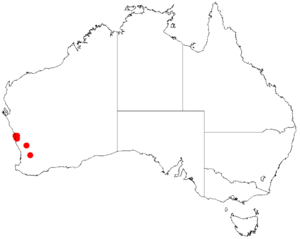Lake Logue wattle facts for kids
Quick facts for kids Lake Logue wattle |
|
|---|---|
| Conservation status | |
| Scientific classification | |
| Genus: |
Acacia
|
| Species: |
vittata
|
 |
|
| Occurrence data from AVH | |
The Lake Logue wattle (scientific name: Acacia vittata) is a special type of shrub. It belongs to the Acacia family, also known as wattles. This plant is found only in a small part of western Australia. This means it is endemic to that area.
Contents
What Does the Lake Logue Wattle Look Like?
This thick shrub usually grows between 1 and 4 meters (about 3 to 13 feet) tall. It has a round shape. Its branches have stripes of green and brown. The green parts are smooth, and the brown parts are slightly hairy and sticky like resin.
Like most Acacia plants, it doesn't have true leaves. Instead, it has special leaf-like parts called phyllodes. These phyllodes grow upwards and are tough and smooth. They are shaped like narrow ovals, about 3 to 5.5 centimeters (1 to 2 inches) long. They are also about 3.5 to 7 millimeters wide. Many small veins run through them, some of which are sticky and white.
Flowers and Seed Pods
The Lake Logue wattle blooms in August. It produces bright yellow flowers. These flowers grow in groups of two or three round clusters. Each cluster is about 4.5 millimeters across and holds 29 to 31 golden flowers.
After the flowers, leathery seed pods grow. These pods are hairy and sticky. They are wavy but don't squeeze in between the seeds. Each pod can be up to 3 centimeters long and 4 to 5 millimeters wide. Inside, the seeds are arranged lengthwise. The seeds are dark brown and slightly shiny. They are about 3 to 4 millimeters long and have a creamy-white cap called an aril.
How Was the Lake Logue Wattle Named?
The Lake Logue wattle was first officially described in 1999. Two botanists, Richard Sumner Cowan and Bruce Maslin, gave it its scientific name, Acacia vittata. They wrote about it in a science journal called Nuytsia.
Later, in 2003, another botanist named Leslie Pedley changed its name to Racosperma vittatum. But then, in 2006, it was moved back to the Acacia group. This shows how scientists sometimes change plant names as they learn more!
Acacia vittata is part of a group of wattles called the Acacia flavipila group. It is thought to be closely related to Acacia verricula. Its phyllodes also look a lot like those of Acacia recurvata.
Where Does the Lake Logue Wattle Grow?
This special wattle lives in the Mid West region of Western Australia. It likes to grow near the edges of lakes that dry up and fill with water depending on the season. It prefers sandy or sandy-clay soils.
You can find it in a small area near a town called Eneabba. It is especially common around Lake Eneabba. It usually grows in areas with low woodlands or open forests.


